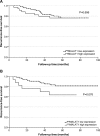Long non-coding RNA metastasis associated in lung adenocarcinoma transcript 1 (MALAT1) interacts with estrogen receptor and predicted poor survival in breast cancer
- PMID: 27191888
- PMCID: PMC5122363
- DOI: 10.18632/oncotarget.9364
Long non-coding RNA metastasis associated in lung adenocarcinoma transcript 1 (MALAT1) interacts with estrogen receptor and predicted poor survival in breast cancer
Abstract
Metastasis associated in lung adenocarcinoma transcript 1 (MALAT1), a lncRNA that was first recognized as a prognostic parameter for patient survival of stage I lung cancer, is up-regulated in multiple human malignancies, including breast cancer. However, the mechanism of its function remained elusive. In the current study, by examining MALAT1 expression on mRNA level, we demonstrated that compared with MCF10A, MALAT1 expression was up-regulated in the majority of breast cancer cell lines (9/12). In 26 pairs of estrogen receptor (ER)-positive breast cancer samples, MALAT1 expression was significantly up-regulated compared with adjacent normal tissues (P = 0.012). Furthermore, of 204 breast cancer patients, high MALAT1 expression was associated with positive ER (P = 0.023) and progesterone receptor (PR) (P = 0.024) status. Further analysis using TCGA database revealed that ER and its target genes PGR and CCND1, were overexpressed in MALAT1 altered group compared with unaltered group, both on the mRNA and protein level. Lastly, we verified MALAT1's prognostic value in breast cancer. At the cut-off value of 75%, MALAT1 was the only independent prognostic factor of recurrence-free survival (RFS) in ER-negative patients in a multivariate Cox regression model (hazard ratio [HR] = 2.83, 95% confidence interval [CI] 1.02-7.83). MALAT1 overexpression was also associated with poor RFS in tamoxifen treated ER-positive breast cancer patients, which might serve as a potential biomarker to predict endocrine treatment sensitivity.
Keywords: MALAT1; breast cancer; estrogen receptor; long non-coding RNA.
Conflict of interest statement
None.
Figures




Similar articles
-
High expression of long non-coding RNA MALAT1 in breast cancer is associated with poor relapse-free survival.Breast Cancer Res Treat. 2018 Sep;171(2):261-271. doi: 10.1007/s10549-018-4839-2. Epub 2018 May 29. Breast Cancer Res Treat. 2018. PMID: 29845475 Free PMC article.
-
Functional and prognostic significance of long non-coding RNA MALAT1 as a metastasis driver in ER negative lymph node negative breast cancer.Oncotarget. 2016 Jun 28;7(26):40418-40436. doi: 10.18632/oncotarget.9622. Oncotarget. 2016. PMID: 27250026 Free PMC article.
-
A Potential Prognostic Long Noncoding RNA Signature to Predict Recurrence among ER-positive Breast Cancer Patients Treated with Tamoxifen.Sci Rep. 2018 Feb 16;8(1):3179. doi: 10.1038/s41598-018-21581-w. Sci Rep. 2018. PMID: 29453409 Free PMC article.
-
Diagnostic, prognostic, and therapeutic significance of long non-coding RNA MALAT1 in cancer.Biochim Biophys Acta Rev Cancer. 2021 Apr;1875(2):188502. doi: 10.1016/j.bbcan.2021.188502. Epub 2021 Jan 8. Biochim Biophys Acta Rev Cancer. 2021. PMID: 33428963 Review.
-
Elevated long noncoding RNA MALAT-1 expression is predictive of poor prognosis in patients with breast cancer: a meta-analysis.Biosci Rep. 2020 Aug 28;40(8):BSR20200215. doi: 10.1042/BSR20200215. Biosci Rep. 2020. PMID: 32700729 Free PMC article.
Cited by
-
Non-Coding RNAs Modulating Estrogen Signaling and Response to Endocrine Therapy in Breast Cancer.Cancers (Basel). 2023 Mar 7;15(6):1632. doi: 10.3390/cancers15061632. Cancers (Basel). 2023. PMID: 36980520 Free PMC article. Review.
-
Beyond regulations at DNA levels: A review of epigenetic therapeutics targeting cancer stem cells.Cell Prolif. 2021 Feb;54(2):e12963. doi: 10.1111/cpr.12963. Epub 2020 Dec 13. Cell Prolif. 2021. PMID: 33314500 Free PMC article. Review.
-
Long non-coding RNAs in breast cancer metastasis.Noncoding RNA Res. 2020 Nov 16;5(4):208-218. doi: 10.1016/j.ncrna.2020.11.004. eCollection 2020 Dec. Noncoding RNA Res. 2020. PMID: 33294746 Free PMC article. Review.
-
The regulation of RNA metabolism in hormone signaling and breast cancer.Mol Cell Endocrinol. 2021 Jun 1;529:111221. doi: 10.1016/j.mce.2021.111221. Epub 2021 Mar 10. Mol Cell Endocrinol. 2021. PMID: 33711334 Free PMC article. Review.
-
Estrogen receptor β promotes the vasculogenic mimicry (VM) and cell invasion via altering the lncRNA-MALAT1/miR-145-5p/NEDD9 signals in lung cancer.Oncogene. 2019 Feb;38(8):1225-1238. doi: 10.1038/s41388-018-0463-1. Epub 2018 Sep 24. Oncogene. 2019. PMID: 30250297
References
-
- Ji P, Diederichs S, Wang W, Böing S, Metzger R, Schneider PM, Tidow N, Brandt B, Buerger H, Bulk E, Thomas M, Berdel WE, Serve H, et al. MALAT-1, a novel noncoding RNA, and thymosin beta4 predict metastasis and survival in early-stage non-small cell lung cancer. Oncogene. 2003;22:8031–41. - PubMed
MeSH terms
Substances
LinkOut - more resources
Full Text Sources
Other Literature Sources
Medical
Research Materials

